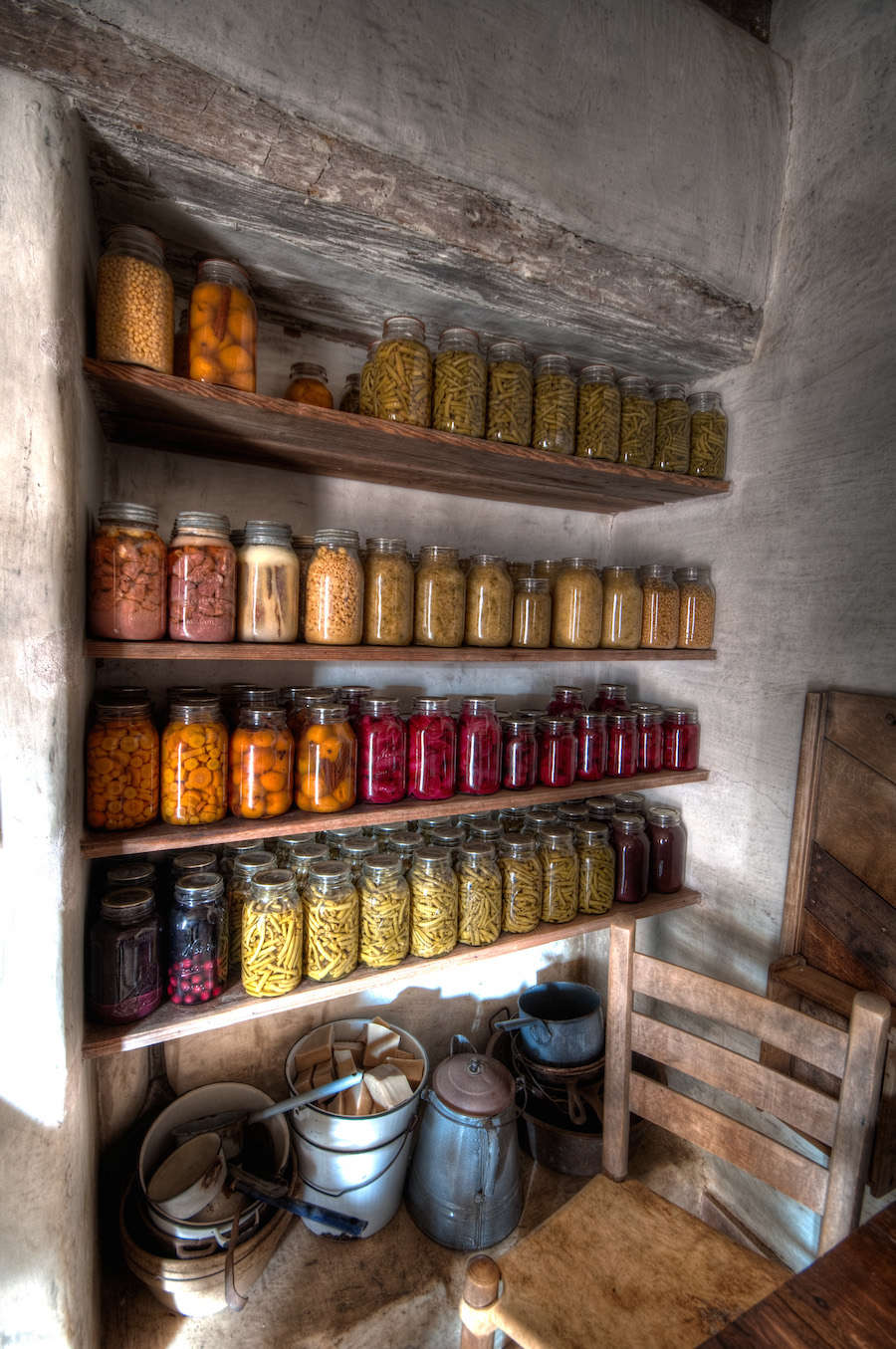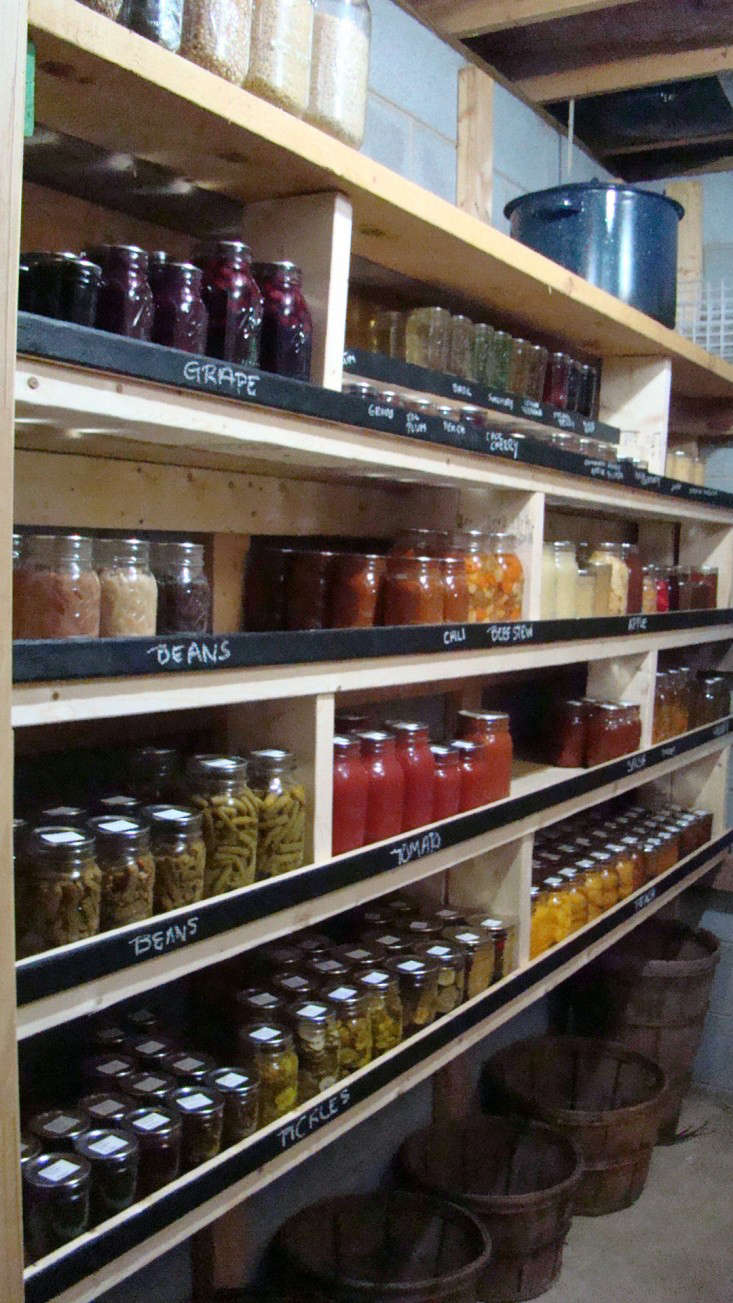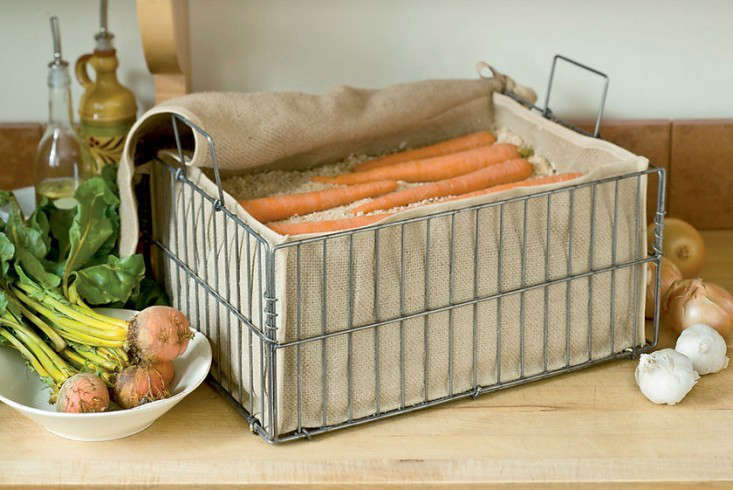
Anyone hunting for a home in the last decade was sure to get an earful about the wine cellar. It was the room de rigueur when it came to home renovations. No home was complete without one, so they appeared in virtually any available nook and cranny. Old basement? Wine cellar! That vacant space under the garage stairs? Wine cellar! But, how many of us really have a collection of 500 vintage wines? What we do have is food. And, the abundance of local farmers markets and even our own vegetable gardens has us thinking, will the root cellar become the new wine cellar? We think it should. Above: Photograph via More Love XOXO.
Above: Photograph via More Love XOXO.
A modern root cellar and a pantry have much in common.
What is a root cellar?
Root cellars predate refrigeration, taking advantage of the earth’s natural cooling, insulating, and humidifying properties to protect and extend the life of food stores. Usually built underground or into the ground, this space is so-called because the primary use historically was storing root crops to extract the maximum usable life out of them. Ideal for more than root vegetables, “cold cellar” might be a better name. Above: Vegetable haul. Photograph by Erin Boyle. For more, see Cheat Sheet: How to Keep Vegetables Fresh Longer.
Above: Vegetable haul. Photograph by Erin Boyle. For more, see Cheat Sheet: How to Keep Vegetables Fresh Longer.
How does a root cellar work?
A root cellar preserves food because it is both cool and humid – the soil underground keeps the space above freezing temperature and the moisture in the air prevents vegetables from losing water and becoming rubbery. The key is cool, with an ideal cellar temperature range somewhere between 32 to 45 degrees Fahrenheit. Relative humidity should be 80 to 90 percent.
Scientifically speaking, this system works by slowing the release of ethylene gas from the crops and stopping the growth of microorganisms that cause decomposition. The humidity level prevents loss of moisture through evaporation. The flavor and texture of vegetables change very little while they’re in storage, and they retain most of their nutritional value.

Above: A root cellar isn’t entirely ineffective if it doesn’t meet the ideal conditions noted above, but it performs better when it can. Thermometers and hygrometers can be used to monitor cellar conditions.
Are root cellars just for root vegetables?
No. While sturdy root vegetables are great candidates for cellaring, many other vegetables and fruits from the fall bounty can be stored. Above: Photograph via Shenandoah Valley Flowers.
Above: Photograph via Shenandoah Valley Flowers.
Particularly good are biennial vegetables, from plants that flower and set seed during the following season, meaning they’re programmed for long storage. That includes members of the squash family, apples, beets, potatoes and onions. Other unsuspecting edibles like leeks, brussels sprouts, peppers, and citrus fruits can last in a cold room for periods of two to eight weeks, depending on the type of vegetable and the conditions. Above: Root cellars also provide storage for nuts and seeds. Photograph via The Rigneys.
Above: Root cellars also provide storage for nuts and seeds. Photograph via The Rigneys.
How do you design a root cellar?
Traditional root cellars are built into the side of a hill, affording entry while also getting the natural benefits of underground storage. Short of drawing up complex plans and embarking on a major construction project, there are many ways to retro-fit a natural cold food storage space into many different home and garden situations.
The simplest strategy may be to turn your basement, or a corner of it, into a cold storage cellar. This can be done at little expense with the addition of shelves, bins, and other storage containers preferably placed in the dampest spot and against exterior walls that are in contact with soil (for the optimal temperature and humidity conditions). Hobby Farms offers a complete guide titled How to Build a Root Cellar in Your Basement.
A portion of an outdoor storage shed can be insulated to protect from freezing and devoted to winter food storage.
Have an available patch of dirt? Create an instant root cellar by digging a pit for a metal garbage can, submerging it so its top is level with the ground, and then using straw to line and top your mini cellar. See Inhabitat’s Build a Backyard Root Cellar for more ideas.
Even a mound of earth can keep a number of root vegetables fresh for months. By encasing these vegetables in straw or newspaper or just in loosened dirt, the root crops will be preserved all winter long (critters may be the only threat in this instance.) Above: A basement corner root cellar stores canned goods and apples. Photograph by Moonmeadow via Flickr.
Above: A basement corner root cellar stores canned goods and apples. Photograph by Moonmeadow via Flickr.
I live in the city with no basement to be found; what are my options?
Any amount of controlled environment will enhance the longevity of some fruits and most vegetables. So when refrigerator space gets too tight for the fall bounty, urban dwellers can store their crops by setting up a root cellar-equivalent in a cold drafty cupboard, by using an insulated cooler filled with straw on a balcony, creating an insulated window basket, or even storing them in sand.
“Keeping root vegetables in sand is a trick that farmers have often relied on to extend the freshness of fall crops into the winter. Farmers can keep whole bushels of carrots, beets, and parsnips in oversized wooden crates filled with moist sand or sawdust and left in a cool, dark place,” explains Erin in our earlier feature Roots in the Sand: Winter Vegetable Storage. “Lucky for folks with smaller grow operations, we found a smaller-scale model for more modest harvests.”

Above: To keep carrots and beets fresh, alternate layers of vegetables with moist sand or sawdust. Use the same bin for storing potatoes, turnips, or winter squash, but leave out the sand. The Root Storage Bin is made from a wire frame and jute liner; $34.95 from Gardener’s Supply.
Any tips for root cellar storage?
 Store vegetables and fruits in containers that allow air to circulate from top to bottom, such as natural baskets, wooden crates, and racks with spacing.
Store vegetables and fruits in containers that allow air to circulate from top to bottom, such as natural baskets, wooden crates, and racks with spacing.
Be gentle with the vegetables you plan to store, as bruised produce will spoil at a faster rate.
To prepare most root vegetables for winter storage, trim the green tops, leaving a one-inch stub to prevent decay. Be careful not to cut the root tips or root flesh (like bruises this will invite spoilage).
The temperature in a root cellar is never uniform; typically it gets warmer the higher you go. Consider your placement of produce accordingly, putting those that tolerate warmer temperatures well, such as onions, garlic, and shallots higher up. Above: Fresh vegetables and fruits last different lengths of time when stored in a root cellar, but potatoes probably last the longest among vegetables; apples among fruit.
Above: Fresh vegetables and fruits last different lengths of time when stored in a root cellar, but potatoes probably last the longest among vegetables; apples among fruit.
Different crops like different conditions. Refer to Nancy and Mike Bubel’s decades old book, Root Cellaring: Natural Cold Storage of Fruits and Vegetables that is still considered the definitive root cellar guide and encyclopedia; $11.44 at Amazon.
For more food storage solutions, see:






Have a Question or Comment About This Post?